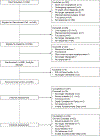Optimization of a technology-supported physical activity promotion intervention for breast cancer survivors: Results from Fit2Thrive
- PMID: 34812521
- PMCID: PMC8837679
- DOI: 10.1002/cncr.34012
Optimization of a technology-supported physical activity promotion intervention for breast cancer survivors: Results from Fit2Thrive
Abstract
Background: The benefits of moderate to vigorous physical activity (MVPA) for breast cancer survivors are well established. However, most are insufficiently active. Fit2Thrive used the Multiphase Optimization Strategy methodology to determine the effect of 5 intervention components on MVPA in this population.
Methods: Two hundred sixty-nine participants (mean age, 52.5 years; SD, 9.9 years) received a core intervention (the Fit2Thrive self-monitoring app and Fitbit) and were randomly assigned to 5 intervention components set to on/off in a full factorial experiment: support calls, deluxe app, buddy, online gym, and text messages. The intervention was delivered over 12 weeks with a 12-week follow-up. MVPA was measured via accelerometry at the baseline (T1), at 12 weeks (T2), and at 24 weeks (T3). The main effects and interaction effects at each time point were examined for all components.
Results: Trial retention was high: 91.8% had valid accelerometer data at T2 or T3. Across all conditions, there were significant increases in MVPA (+53.6 min/wk; P < .001) and in the proportion of survivors meeting MVPA guidelines (+22.3%; P < .001) at T2 that were maintained but attenuated at T3 (MVPA, +24.6 min/wk; P < .001; meeting guidelines, +12.6%; P < .001). No individual components significantly improved MVPA, although increases were greater for the on level versus the off level for support calls, buddy, and text messages at T2 and T3.
Conclusions: The Fit2Thrive core intervention (the self-monitoring app and Fitbit) is promising for increasing MVPA in breast cancer survivors, but the components provided no additional increases in MVPA. Future research should evaluate the core intervention in a randomized trial and determine what components optimize MVPA behaviors in breast cancer survivors.
Keywords: behavior change; breast cancer survivors; digital health; intervention; physical activity.
© 2021 American Cancer Society.
Conflict of interest statement
The authors have no conflict of interests to report.
Figures
References
-
- Ibrahim EM, Al-Homaidh A. Physical activity and survival after breast cancer diagnosis: meta-analysis of published studies. Med Oncol. 2011;28:753–765. - PubMed
-
- Speck RM, Courneya KS, Masse LC, Duval S, Schmitz KH. An update of controlled physical activity trials in cancer survivors: a systematic review and meta-analysis. J Cancer Surviv. 2010;4:87–100. - PubMed


